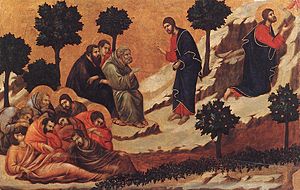
Tristis est anima mea is the second responsory of the Tenebrae for Maundy Thursday. The Latin text refers to Christ's Agony in the Garden of Gethsemane, a part of his Passion.

Tristis est anima mea is the second responsory of the Tenebrae for Maundy Thursday. The Latin text refers to Christ's Agony in the Garden of Gethsemane, a part of his Passion.
The theme of the text of the second responsory for Maundy Thursday is Jesus in the garden Gethsemane, addressing his disciples.
The first two lines of the responsory are Matthew26:38. [1] In the King James Version, the beginning of the Latin text, told in the first person, is translated as "My soul is exceeding sorrowful". [2]
While the first two lines are quoted from the bible, the last two lines of are free anonymous poetry, predicting they will see a crowd, they will flee, and Jesus will go to be sacrificed for them. [1]
Responsorium: [3]
Tristis est anima mea usque ad mortem :
sustinete hic, et vigilate mecum :
nunc videbitis turbam, quæ circumdabit me.
Vos fugam capietis, et ego vadam immolari pro vobis.
Versus:
Ecce appropinquat hora, et Filius hominis tradetur in manus peccatorum.
Vos fugam capietis, et ego vadam immolari pro vobis.
Translations are offered by the Episcopal Church [4] and the Roman Catholic Church: [3]
Responsorium:
My soul is sorrowful even unto death ;
stay you here, and watch with me.
Now ye shall see a multitude, that will surround me.
Ye shall run away, and I will go to be sacrificed for you.
Versus:
Behold the hour is at hand, and the Son of Man shall be betrayed into the hands of sinners.
Ye shall run away, and I will go to be sacrificed for you.


Motets and other musical settings based on the responsory:
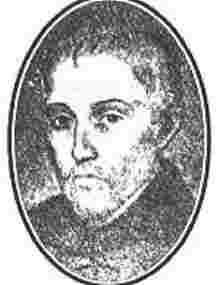
Tomás Luis de Victoria was the most famous Spanish composer of the Renaissance. He stands with Giovanni Pierluigi da Palestrina and Orlande de Lassus as among the principal composers of the late Renaissance, and was "admired above all for the intensity of some of his motets and of his Offices for the Dead and for Holy Week". His surviving oeuvre, unlike that of his colleagues, is almost exclusively sacred and polyphonic vocal music, set to Latin texts. As a Catholic priest, as well as an accomplished organist and singer, his career spanned both Spain and Italy. However, he preferred the life of a composer to that of a performer.
Pomponio Nenna was a Neapolitan Italian composer of the Renaissance. He is mainly remembered for his madrigals, which were influenced by Gesualdo, and for his polychoral sacred motets, posthumously published as Sacrae Hebdomadae Responsoria in 1622.
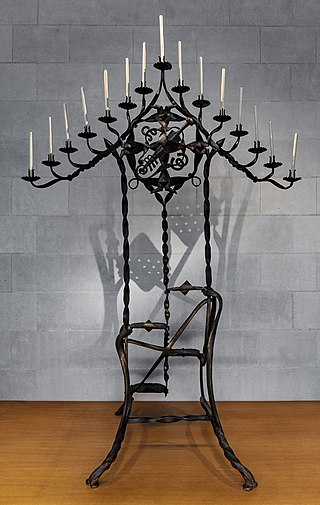
Tenebrae is a religious service of Western Christianity held during the three days preceding Easter Day, and characterized by gradual extinguishing of candles, and by a "strepitus" or "loud noise" taking place in total darkness near the end of the service.
A responsory or respond is a type of chant in western Christian liturgies.

O vos omnes is a responsory, originally sung as part of Roman Catholic liturgies for Holy Week, and now often sung as a motet. The text is adapted from the Latin Vulgate translation of Lamentations 1:12. It was often set, especially in the sixteenth century, as part of the Tenebrae Responsories for Holy Saturday. Some of the most famous settings of the text are by:
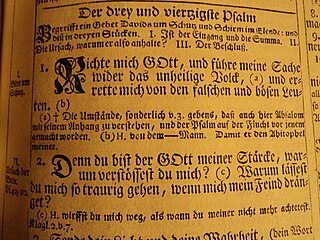
Psalm 43 is the 43rd psalm of the Book of Psalms, known in the English King James Version as "Judge me, O God, and plead my cause against an ungodly nation". In the slightly different numbering system used in the Greek Septuagint and Latin Vulgate translations of the Bible, this psalm is Psalm 42. In Latin, it is known as "Iudica me Deus". It is commonly attributed to the sons of Korah. In the Hebrew Bible, it comes within the second of the five books (divisions) of Psalms, also known as the "Elohistic Psalter" because the word YHWH is rarely used and God is generally referred to as "Elohim".
Responsoria et alia ad Officium Hebdomadae Sanctae spectantia is a collection of music for Holy Week by Italian composer Carlo Gesualdo, published in 1611. It consists of three sets of nine short pieces, one set for each of Maundy Thursday, Good Friday and Holy Saturday, and a psalm and a hymn. The work was written for unaccompanied voices: two soprano parts, alto, two tenor parts, and bass.
The Sacrae Cantiones of Carlo Gesualdo da Venosa are two collections of motets published in 1603. The first volume consists of 19 motets for 5 voices, the second volume of 20 motets for 6 or 7 voices. The bassus and sextus of the second volume are lost, but were reconstructed by musicologist James Wood from 2008 to 2011 and recorded by Wood's Vocalconsort Berlin in August 2011.
Christus factus est is taken from Saint Paul's Epistle to the Philippians. It is a gradual in the Catholic liturgy of the mass. In the classical Roman rite, it was sung as the gradual at mass on Maundy Thursday, however since the promulgation of the new rite of mass by Pope Paul VI in 1969 it has been employed instead as the gradual on Palm Sunday. Up until 1970 it was also sung daily at the conclusion of Tenebrae on the last days of Holy Week. It appeared first at Tenebrae of Maundy Thursday, but was not recited in full, ending with ...'usque ad mortem'. The following day at Tenebrae of Good Friday it was sung from the beginning until ...'mortem autem crucis' and at Tenebrae of Holy Saturday it was sung in full. Up until the reform of the Holy Week liturgy promulgated by Pius XII in 1955 these Tenebrae services were sung in the late afternoon and evening of the previous day, and were well attended by the laity. Thus Tenebrae of Maundy Thursday was sung during the evening of Spy Wednesday; Tenebrae of Good Friday in the evening Maundy Thursday etc. For this reason Christus factus est was set by many composers of church music. From 1956–1969, and in the liturgical books of 1962 which are currently in use as the extraordinary form of the Roman Rite, these services have been 'restored' to the early morning of the last three days of Holy Week, with the effect that complex musical settings of this text are rarely heard in their authentic liturgical context.

Tristis est anima mea is a sacred motet for five voices attributed to Johann Kuhnau, Thomaskantor in Leipzig. The text is the second responsory at Tenebrae for Maundy Thursday, one of the Latin texts kept in the liturgy after the town converted to Lutheranism.
Tristis est anima mea is the Latin phrase with which Matthew 26:38 starts. It is Tristis est anima mea (responsory), the second responsory of the Tenebrae for Maundy Thursday which was often set to music. It may also refer to:
Quatre motets pour un temps de pénitence, FP 97, are four sacred motets composed by Francis Poulenc in 1938–39. He wrote them on Latin texts for penitence, scored for four unaccompanied voices.
Tenebrae responsories are the responsories sung following the lessons of Tenebrae, the Matins services of the last three days of Holy Week: Maundy Thursday, Good Friday and Holy Saturday. Polyphonic settings to replace plainchant have been published under a various titles, including Responsoria pro hebdomada sancta.
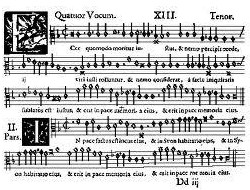
The righteous perishes are the words with which the 57th chapter of the Book of Isaiah starts. In Christianity, Isaiah 57:1–2 is associated with the death of Christ, leading to liturgical use of the text at Tenebrae: the 24th responsory for Holy Week, "Ecce quomodo moritur justus", is based on this text. More generally, the text is associated with the death of loved ones and is used at burials. As such, and in other versions and translations, the Bible excerpt has been set to music.
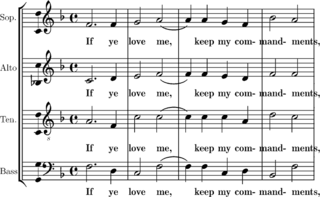
"If ye love me" is a four-part motet or anthem by the English composer Thomas Tallis, a setting of a passage from the Gospel of John. First published in 1565 during the reign of Elizabeth I, it is an example of Tudor music and is part of the repertoire of Anglican church music. An early English-language motet, it is frequently performed today, and has been sung at special occasions including a papal visit and a royal wedding.

Popule meus is a motet for Good Friday by Tomás Luis de Victoria. He set a liturgical text from the Improperia, which contains the Greek-Latin Trisagion, prescribed for use in the Catholic responsory for Good Friday. It begins "Popule meus, quid feci tibi?". The composition, scored for four voices, SATB, was published in Rome in 1585 in Officium Hebdomadae Sanctae.
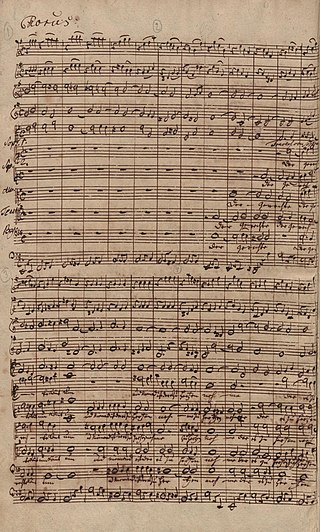
Der Gerechte kömmt um, BWV 1149, is a motet for SSATB singers and instrumental ensemble, which, for its music, is based on the five-part a cappella motet Tristis est anima mea attributed to Johann Kuhnau, and has the Luther Bible translation of Isaiah 57:1–2 as text. The arrangement of the Latin motet, that is, transposing it to E minor, adjusting its music to the new text, and expanding it with an instrumental score for two traversos, two oboes, strings and basso continuo, is attributed to Johann Sebastian Bach. The setting is found in a manuscript copy, likely written down in the 1750s, of Wer ist der, so von Edom kömmt, a Passion oratorio which is a pasticcio based on compositions by, among others, Carl Heinrich Graun, Georg Philipp Telemann and Bach. Likely Der Gerechte kömmt um existed as a stand-alone motet, for example for performance on Good Friday or at a funeral, before being adopted in the pasticcio.